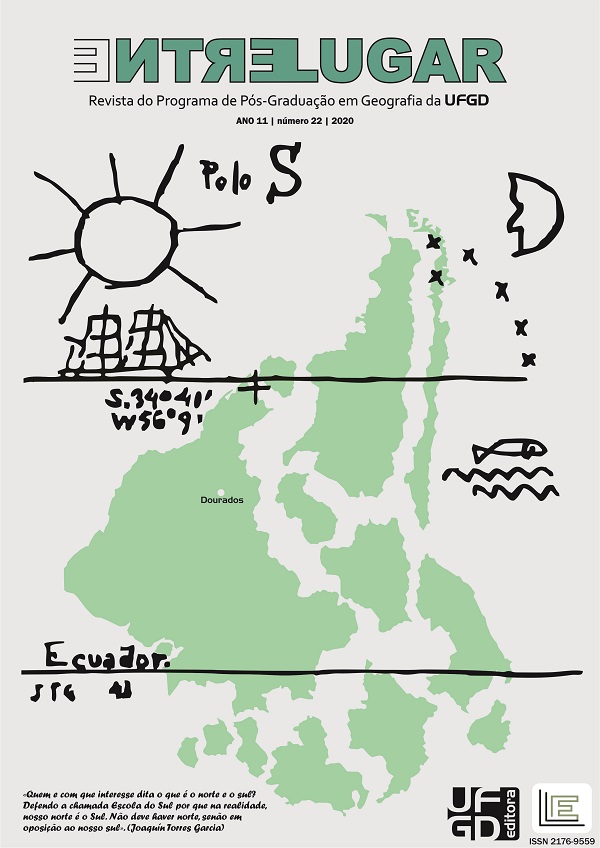Commodification of urban climates and the creation of socioclimatic injustices in Santiago de Chile
DOI:
https://doi.org/10.30612/el.v11i22.12868Keywords:
Environmental injustice. Urban microclimate. Urban ventilation. ENVI-met. Microclimate simulation.Abstract
Santiago de Chile is an example of a concentration of political power, economic activities and socio-environmental problems in Latin America. Through the analysis of satellite images and microclimate simulations using ENVI-met model, the objective was to analyze the transformations in land use and land cover associated with its recent urbanization at the scale of Local Climate Zones and their thermal and ventilation attributes, in two communes with different designs: Estación Central, lower middle class with the so-called “vertical ghettos”, and Vitacura, upper class with the so-called “Sanhattan”. While disorderly urban growth with buildings 100 m high at Estación Central adversely changed the urban climate, increasing hot spots, reducing humidity and hindering ventilation, in Vitacura buildings coexist in harmony with green infrastructure, wide avenues and wooded areas.
Downloads
References
ARISTODEMOU, E.; BOGANEGRA, L.M.; MOTTET, L.; PAVLIDIS, D.; CONSTANTINOU, A.; PAIN, C.; ROBINS, A.; APSIMON, H. How tall buildings affect turbulent air flows and dispersion of pollution within a neighbourhood. Environmental Pollution, v. 233, p. 782-796, 2018. https://doi.org/10.1016/j.envpol.2017.10.041
BAKKER, K.; BRIDGE, G. Material words? Resource geographies and the “matter of nature”. Progress in Human Geography, v. 30, n. 1, p. 5-27, 2006. https://doi.org/10.1191/0309132506ph588oa
BILAL, U.; ALAZRAQUI, M.; CAIAFFA, W.T.; LÓPEZ-OLMEDO, N.; MATÍNEZ-FOLGAR, K.; MIRANDA, J.J.; RODRÍGUEZ, D.A.; VIVES, A.; DIEZ-ROUX, A. Inequalities in life expectancy in six large Latin American cities from the SALURBAL study: an ecological analysis. The Lancet Planetary Health, v. 3, n. 12, p. e503-e510, 2019. https://doi.org/10.1016/S2542-5196(19)30235-9
BRUSE, M; FLEER, H. Simulating surface–plant–air interactions inside urban environments with a three dimensional numerical model. Environmental Modelling & Software, v. 13, n. 3-4, p. 373–384, 1998. https://doi.org/10.1016/S1364-8152(98)00042-5
CASTREE, N. Commodifying what nature. Progress in Human Geography, v. 27, n. 3, p. 273-297, 2003. https://doi.org/10.1191/0309132503ph428oa
ENVI-met. 2020. Disponível em: <https://www.envi-met.com/>. Acesso em: 20 out. 2020.
HUANG, J.M.; CHEN, L.C. A Numerical Study on Mitigation Strategies of Urban Heat Islands in a Tropical Megacity: A Case Study in Kaohsiung City, Taiwan. Sustainability, v. 12, n. 10, p. 3952-3973, 2020. https://doi.org/10.3390/su12103952
IRARRÁZAVAL, F.I. El imaginario" verde" y el verde urbano como instrumento de consumo inmobiliario: configurando las condiciones ambientales del área metropolitana de Santiago. Revista INVI, v. 27, n. 75, p. 73-103, 2012.
JIMÉNEZ-YAÑEZ, C. # Chiledespertó: causas del estallido social en Chile. Revista Mexicana de Sociología, v. 82, n. 4, p. 949-957, 2020. http://dx.doi.org/10.22201/iis.01882503p.2020.4.59213
MENDES, F.H. Tutorial para Iniciantes: software ENVI-met versão 3.1. 2014. Disponível em: <http://cmq.esalq.usp.br/wiki/lib/exe/fetch.php?media=publico:projetos:envi-met31_tutorial_iniciantes.pdf>. Acesso em: 20 out. 2020.
MENDES, F.H.; SOUSA-CAMILO, A.S.; LOPES, A.M.S.; POLIZEL, J.L.; SILVA FILHO, D.F.; ROMERO, H. Comportamiento térmico de diferentes superficies urbanas durante un día cálido de verano. Revista Geográfica de Valparaíso, n. 56, p. 1-8, 2019.
NG, E.; CHEN, L.; WANG, Y.; YUAN, C. A study on the cooling effects of greening in a high-density city: An experience from Hong Kong. Building and Environment, v. 47, p. 256-271, 2012. https://doi.org/10.1016/j.buildenv.2011.07.014
OKE, T.R. Boundary Layer Climates. London: Methuen and Co., 1978.
ROMERO, H.; IRARRÁZAVAL, F.; OPAZO, D.; SALGADO, M.; SMITH, P. Climas urbanos y contaminación atmosférica en Santiago de Chile. EURE (Santiago), v. 36, n. 109, p. 35-62, 2010. http://dx.doi.org/10.4067/S0250-71612010000300002
ROMERO, H. Urban Climates and the Challenge of Sustainable Development of Chilean Cities. En: HENRÍQUEZ, C.; ROMERO, H. Urban Climates in Latin America. Cham: Springer International Publishing, 2019. p. 207-256. https://doi.org/10.1007/978-3-319-97013-4_9
SHOKRY, G.; CONNOLLY, J.; ANGUELOVSKI, I. 2020. Understanding climate gentrification and shifting landscapes of protection and vulnerability in green resilient Philadelphia. Urban Climate 31, 1000539. https://doi.org/10.1016/j.uclim.2019.100539.
SMITH, P.; ROMERO, H. Factores explicativos de la distribución espacial de la temperatura del aire de verano en Santiago de Chile. Revista Geográfica Norte Grande, n. 63, p. 45-62, 2016. http://dx.doi.org/10.4067/S0718-34022016000100004
THORNES, J.; RANDALLS, S. Commodifying the Atmosphere “Pennies from Heaven?” Geografiska Annaler, Series A, Physical Geography, v. 89, n. 4, p. 273-285, 2007. https://doi.org/10.1111/j.1468-0459.2007.00326.x
Downloads
Published
How to Cite
Issue
Section
License
Autores que publicam nesta revista concordam com os seguintes termos:
- Autores mantém os direitos autorais e concedem à revista o direito de primeira publicação, com o trabalho simultaneamente licenciado sob a Creative Commons Atribuição-NãoComercial-CompartilhaIgual 3.0 Brasil que permitindo o compartilhamento do trabalho com reconhecimento da autoria do trabalho e publicação inicial nesta revista.
- Autores têm autorização para assumir contratos adicionais separadamente, para distribuição não-exclusiva da versão do trabalho publicada nesta revista (ex.: publicar em repositório institucional ou como capítulo de livro), com reconhecimento de autoria e publicação inicial nesta revista.
- Autores têm permissão e são estimulados a publicar e distribuir seu trabalho online (ex.: em repositórios institucionais ou na sua página pessoal) a qualquer ponto antes ou durante o processo editorial, já que isso pode gerar alterações produtivas, bem como aumentar o impacto e a citação do trabalho publicado (Veja O Efeito do Acesso Livre).




